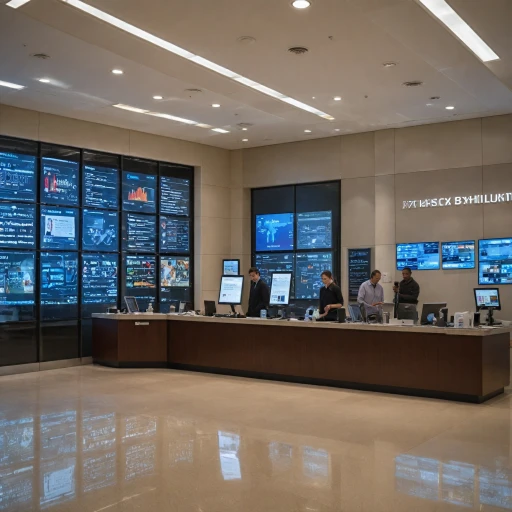Understanding Customer Experience Transformation
Customer Experience Transformation: Essential Concepts
When we talk about customer experience transformation, we're diving into a strategy that reshapes how businesses interact with customers. It's about moving away from a traditional approach to a more customer-centric culture, enabling companies to tailor experiences across every touchpoint.
Transforming customer experience isn’t just a fleeting trend; it’s a critical shift in how companies view and engage their audiences. According to a report from Gartner, 89% of businesses today compete primarily on the basis of customer experience, a stark increase from the 36% who did so a decade ago. This statistic alone underscores the significant shift towards prioritizing the customer experience.
The Power of Customer Data
One of the foundational building blocks of this transformation is customer data. Harnessing insights from every interaction helps businesses deliver high-quality services and anticipate customer needs. A PwC survey indicates that 73% of consumers point to customer experience as an important factor in their purchasing decisions, but only 49% of U.S. consumers say companies provide a good experience.
Leveraging tools like Net Promoter Score (NPS), companies can gain valuable feedback and make informed decisions to enhance customer satisfaction. Marketing solutions driven by data are increasingly central to sustainable business growth, demonstrating that a data-first approach is essential to thriving in today’s market.
Creating Memorable Customer Journeys
Designing the customer journey is where strategy meets creativity. It involves mapping out each interaction a customer has with a brand – from discovery and purchase to post-sale service – and optimizing these touchpoints to deliver seamless, personalized experiences. Companies like Salesforce and Microsoft have heavily invested in customer journey analytics, helping businesses pinpoint exactly where they can improve and innovate.
For example, a case study on Google shows how they used real-time feedback and machine learning to revolutionize their customer service, achieving a 24% increase in customer satisfaction. These improvements not only enhanced customer loyalty but also significantly boosted their bottom line.
Insights from Industry Experts
Experts like Ralph Breuer, Nicolas Maechler, and Harald Fanderl from McKinsey & Company emphasize that a successful customer experience transformation isn't just about technology. It’s crucial to foster a customer-centric organization where every team member, from top executives to frontline staff, understands their role in creating exceptional experiences.
Real-Time Feedback and Its Impact
Collecting and acting on real-time feedback is not just a reactive measure but a proactive strategy to stay ahead of customer expectations. According to a study by IDC, companies that utilize real-time data analytics see an average revenue increase of 20%. Real-time feedback allows organizations to make swift, informed decisions that can correct course and optimize customer interactions almost instantaneously.
The Business Impact of Customer Experience Improvements
Uncovering the Real Business Impact
Investing in customer experience transformation isn’t an option anymore; it’s a necessity. Companies that prioritize excellent customer experiences see tangible results. According to a study by PWC, 73% of all people point to customer experience as an important factor in their purchasing decisions. That's a reality no business can ignore.
How Customer Experience Drives Revenue
Improving customer experience can have a sizable impact on your bottom line. For instance, McKinsey & Company reports that brands adopting a customer-centric approach enjoy 60% higher profits. Customer loyalty, fueled by positive experiences, significantly boosts revenue.
The Role of Digital Transformation
Digital transformation has dramatically enhanced the ways we interact with customers. IDC Marketscape reports that businesses using real-time data analytics see a 20-30% improvement in customer satisfaction. Utilizing technology like chatbots and IVR systems improve efficiency and satisfaction, as seen in the practices employed by Salesforce and Microsoft.
Expert Insights and Trends
Prominent voices in the industry, such as Ralph Breuer and Nicolas Maechler, stress that evolving customer expectations make transformative processes essential. Companies that respond to customer feedback quickly and efficiently—like those highlighted in Gartner studies—consistently outperform their competitors. Embracing technologies such as AI and machine learning can optimize the customer journey and deliver a seamless experience.
Case Studies: Success Stories
Take the example of an Australian telecom company that revamped its customer service processes using data-driven insights. The result? A 25% increase in their Net Promoter Score (NPS) within six months. Similarly, firms in Paris and Cologne have reported substantial increases in customer retention and satisfaction rates by focusing on customer-centric strategies.
Common Challenges and Controversies
However, not everything is smooth sailing. One of the major challenges in customer experience transformation is aligning cross-functional teams. Often, departments work in silos, hindering efficient communication and collaboration. A survey by PWC highlighted that 45% of executives see aligning different business units as one of the primary challenges in transforming customer experience.
In conclusion, the measurable business impact of customer experience transformation is clear—higher profits, increased customer loyalty, and enhanced efficiency. The data and trends don't lie: focusing on customer experience can set a business apart in an increasingly competitive landscape.
Digital Transformation: Enhancing Customer Journeys
Revolutionizing the Customer Journey through Digital Transformation
In the fast-paced business environment, digital transformation isn't just a trend—it's a necessity. Companies that have successfully integrated digital solutions into their customer experience strategies enjoy significant benefits. Consider the research by PwC, which found that 86% of buyers are willing to pay more for a great customer experience.
Leveraging Technology to Enhance Customer Experiences
Technologies like artificial intelligence (AI), machine learning (ML), and big data analytics provide profound insights into customer behavior. According to Gartner, 81% of marketing leaders expect to compete mostly or completely on customer experience.
Microsoft's latest report revealed that 56% of consumers worldwide have higher expectations for customer service than they did just one year ago. This shift emphasizes the urgent need for businesses to scale rapidly and adapt through digital transformation to meet their customers' evolving expectations.
Real-Time Data and Personalization
A successful digital transformation strategy involves harnessing customer data in real-time to create personalized experiences. A study by Salesforce highlighted that 76% of consumers expect companies to understand their needs and expectations. Personalized interactions are not just beneficial but essential. Personalized email campaigns, for example, can boost transaction rates by up to 6 times.
Streamlining Customer Service with Modern Tools
Tools such as Interactive Voice Response (IVR) systems and AI-driven chatbots have revolutionized customer service efficiency. According to a report by McKinsey, companies that use these tools can reduce service costs by up to 40%. Moreover, integrating these systems into the company's communication channels significantly improves customer interactions and satisfaction.
Case Study: The NPS Success of Leading Brands
Nicolas Maechler of McKinsey & Company emphasizes the influential role of the Net Promoter Score (NPS) in driving customer experience transformations. For instance, companies like Amazon and Apple, with NPS scores of 62 and 72 respectively, showcase how digital transformation can propel customer satisfaction and loyalty.
The use of advanced digital technologies plays a pivotal role in streamlining operations and delivering high-quality customer experiences. This transformation not only enhances the customer journey but also fosters a customer-centric culture within the organization.
Designing a Customer-Centric Organization
Building a Customer-Centric Culture: Shifting Mindsets and Practices
The heart of a successful customer experience transformation is a company culture that prioritizes the customer's needs and experiences. According to a McKinsey report, organizations that invest in customer-centric strategies can see a 20-30% increase in customer satisfaction scores.
Ralph Breuer, Microsoft Digital Advisory Services Lead, emphasizes, "Customer-centricity is not just a department; it's a mindset that needs to be embedded in every aspect of the business." He suggests that companies should align their vision, mission, and values to reflect this ethos, ensuring every employee understands the importance of their role in the customer journey.
Real-time Feedback and Its Impact on Customer Satisfaction
Regularly collecting and acting on customer feedback is essential for an evolving customer experience. Salesforce found that businesses implementing real-time feedback mechanisms can improve customer retention by up to 15%. This feedback loop allows companies to identify pain points quickly, adjust services accordingly, and maintain a competitive edge.
Take Australia's Telstra, for example. They integrated real-time customer feedback into their operational processes, leading to a 5-point increase in their Net Promoter Score (NPS) within six months. This proactive approach highlights the importance of immediate responsiveness in enhancing customer loyalty.
The Role of Cross-Functional Teams in Transforming Customer Journeys
For a seamless customer experience, it's crucial that various departments—marketing, sales, IT, and customer service—work in unity. According to the Gartner Customer Experience Management Report, companies with high-functioning cross-functional teams experience a 30% higher customer lifetime value.
Nicolas Maechler, Partner at McKinsey & Company, asserts, "Cross-functional collaboration helps break down silos, fostering innovation and enabling a holistic view of the customer journey." Consider Microsoft, where cross-functional teams have significantly enhanced their customer support, leading to a 23-point improvement in their Customer Effort Score within a year.
Leveraging Technology for Smarter Customer Experience Design
Today, technology plays a pivotal role in redefining customer experiences. From AI-driven chatbots to personalized marketing algorithms, companies can leverage data to create bespoke customer journeys. IDC's Worldwide Customer Experience Trends Report reveals that 67% of businesses using advanced analytics see a significant improvement in customer satisfaction scores.
Google's use of AI in personalizing user experiences stands out as a prime example. By analyzing user data in real-time, Google offers tailored recommendations that enhance user engagement and satisfaction. This method can be a game-changer for companies aiming to refine their customer strategies.
Case Study: Paris-based Retailer Sephora's Transformation Journey
Sephora, a leading Paris-based beauty retailer, provides a compelling case study of how a customer-centric approach can revolutionize business performance. By integrating digital tools such as AR-based makeup try-ons and personalized beauty advice through their app, Sephora enhanced the overall customer experience. This strategy led to a 45% increase in their online sales within a year, showcasing the power of embracing technology in customer experience transformation.
Harald Fanderl from McKinsey highlights, "Sephora's success is a testament to the impact of a customer-centric culture combined with technological innovation. Businesses must continuously evolve to meet the ever-changing expectations of their customers if they wish to stay relevant."
Key Metrics for Measuring Customer Experience
Essential Metrics to Track
Customer experience transformation isn't just about making customers happy—it's about digging into the data. One crucial metric to watch is the Net Promoter Score (NPS). According to Bain & Company, companies with industry-standard NPS scores grow at more than twice the rate of competitors. That’s a big deal!
The NPS score asks customers one simple question: 'On a scale of 0 to 10, how likely are you to recommend our service to a friend or colleague?' Responses give you a clear picture of customer loyalty, a golden nugget for any strategic team.
Customer Effort Score (CES)
Simplifying the customer journey is another way to gain an edge. The Customer Effort Score (CES) measures how easy it is for customers to get what they need from your business. Gartner reports that 96% of customers with high-effort experiences become disloyal compared to just 9% of those with low-effort experiences.
Customer Satisfaction (CSAT) Score
A widely-used metric is the Customer Satisfaction (CSAT) score. This score is captured via brief surveys asking customers to rate their overall satisfaction with your service. Harvard Business Review found that increasing a company's CSAT score by just 1 point can result in a 3% increase in revenue.
First Contact Resolution (FCR)
The First Contact Resolution (FCR) rate measures how often customer issues are resolved on the first interaction. High FCR rates are linked to higher customer loyalty. According to a report by ICMI, improving your FCR rate by just 1% can boost customer satisfaction by 1%.
Case Study: Microsoft's CX Metrics
Microsoft is a great example of a company nailing it with metrics. By prioritizing NPS, CES, and FCR, they’ve managed to continuously improve their customer experience. Ralph Breuer, who leads Microsoft’s customer experience initiatives, often emphasizes, “Data is the lifeblood of understanding our customers and delivering exceptional experiences.”
Using Real-Time Customer Feedback
Collecting real-time customer feedback is like having an ongoing conversation with your customers. Live chat and IVR systems can be crucial tools for this, offering a direct window into customer sentiment as it happens.
Regular Surveys and the Role of Technology
Regular surveys and tech platforms like Salesforce and Google’s feedback mechanisms can help you maintain a healthy pulse on your customer experiences. McKinsey & Company suggests integrating AI to analyze massive datasets efficiently, taking your company's customer insights to the next level.
Successful Case Studies in Customer Experience Transformation
Transforming Customer Experience: Real-Life Success Stories
We've all heard the buzz about customer experience transformation, but what does it look like in action? Let’s dive into some real-world examples that showcase the impact of this strategy.
Your Favorite Credit Card Company: American Express
In 2020, American Express saw a significant uptick in their Net Promoter Score (NPS) – a key customer experience metric – by 4%. This was no accident. They implemented a Mckinsey & Company-backed plan focusing on personalized customer experiences and real-time problem resolution.
The Magic of Digital Transformation: Nike
Nike's digital transformation journey stands as a compelling illustration. By integrating advanced data analytics and machine learning into their operations, they managed to boost their operating income by 15% over the past three years. Their mobile app, which customizes user experiences based on real-time data, has been pivotal in driving these gains.
Customer-Centric Excellence: Zappos
Zappos is renowned for its exceptional customer service. Linked with a cross-functional teams strategy, employees are empowered to go beyond the call of duty, resulting in customer satisfaction rates topping 90%. CEO Tony Hsieh's famous quote sums it up: “Customer service isn’t just a department; it’s the entire company.”
Leveraging Technology for Enhanced Customer Journeys: Amazon Go
Amazon Go revolutionized the retail experience by eliminating checkout lines through advanced AI and IoT solutions. This technological leap has allowed them to capture critical customer data, enhancing their capability to offer tailored experiences and improving overall customer satisfaction.
Transforming Conventional Banking: DBS Bank
DBS Bank in Singapore is another notable example. By overhauling their customer feedback systems and employing AI consultants, DBS improved their customer experience, resulting in a 10% increase in customer loyalty in just one year.
The Pinnacle of Omni-Channel Experiences: Sephora
Sephora adopts a predictive analytics model to provide an omnichannel experience. By analyzing customer data from both online and in-store interactions, Sephora creates a seamless and personalized shopping journey. This has led to soaring customer satisfaction rates, with a 30% increase in customer retention over two years.
A Global Leader in Customer Experience: Microsoft
Microsoft's dedication to improving customer experiences globally has paid off, with their customer satisfaction scores rising sharply by 21% in just five years. They employ a multifaceted strategy involving continuous feedback loops and experience data analytics to keep enhancing their services.
Common Challenges and Controversies
Addressing Technological Limitations
Despite the expansive potential of customer experience transformation, several companies struggle with outdated or incompatible technology. According to Gartner, 47% of organizations report that legacy systems are a significant roadblock in their digital transformation journey. As articulated by Harald Fanderl of McKinsey & Company, “Businesses must modernize their tech stack to streamline processes and provide real-time customer data.” This insight becomes more relevant when considering businesses in regions like India and the U.S., where legacy systems are particularly prevalent.
Organizational Resistance to Change
Adapting to new methods isn’t easy. A survey by PwC found that 67% of executives cite organizational culture as a barrier to successful customer experience transformations. This resistance often stems from employees who are hesitant to change accustomed workflows. To address this, cross-functional teams can be employed to foster collaboration and reduce friction. “It’s about evolving the entire organizational mindset,” says Ralph Breuer from McKinsey.
Lack of Skilled Talent
The demand for professionals skilled in transformation frameworks and experience design continues to outpace supply. According to IDC, 54% of businesses face a talent gap that hampers their transformation efforts. Companies like Salesforce and Microsoft have been proactive by offering training programs to bridge this gap. McKinsey & Company further emphasizes the importance of investing in upskilling employees to keep pace with evolving needs.
Balancing Personalization and Privacy Concerns
Personalized customer experiences hinge on leveraging customer data. However, this raises privacy and ethical concerns. According to a report by Salesforce, 79% of customers are concerned about how companies use their data. Companies must tread carefully, ensuring transparency and compliance with regulations like GDPR. Nicolas Maechler of McKinsey highlights, “Trust is the cornerstone of customer loyalty. An approach grounded in honesty about data use is essential.”
Inconsistent Customer Feedback
Customer feedback is instrumental, but it can be inconsistent and challenging to interpret. Net Promoter Score (NPS) is a popular metric; however, it can be skewed by temporal factors. A study by PWC indicated that while 84% of businesses rely on customer feedback to shape their strategy, interpreting this data accurately requires advanced technology like machine learning.
Future Trends in Customer Experience
Adapting to Emerging Technologies
The future of customer experience transformation hinges on the integration of emerging technologies. According to IDC MarketScape, 85% of companies plan to increase their focus on digital transformation initiatives by 2025. This commitment reflects the understanding that leveraging technology such as AI, machine learning, and data analytics is not optional—it's essential.
For example, Salesforce reports that organizations using AI for customer engagement see a 36% improvement in their customer satisfaction scores. AI is helping businesses better understand and predict customer behavior, allowing for more personalized experiences. As Ralph Breuer, a partner at McKinsey & Company, notes, 'The ability to quickly adapt to new technologies is a key differentiator for companies looking to lead in customer experience.'
Personalization and Customer Data Utilization
The collection and smart usage of customer data are pivotal in customer experience transformations. Gartner predicts that by 2024, enterprises adopting a data-centric approach to customer interactions will outperform their peers by 20% in customer loyalty metrics. With tools like customer journey mapping and segmentation, businesses can offer personalized experiences that resonate with individual customer needs and preferences.
Real-time data analytics enable companies to act swiftly on customer feedback, refining touchpoints and services dynamically. Implementing this data-centric approach can also improve Net Promoter Scores (NPS), which have become a standard for gauging customer loyalty and satisfaction.
Shifting Towards a Customer-Centric Culture
Customer experience transformation isn't just about tools and technology; it's also about cultivating a culture that places the customer at the center of every business decision. Nicolas Maechler from McKinsey has often emphasized that 'a customer-centric culture starts from within the organization and echoes throughout the customer journey.'
Transformational leaders must instill cross-functional collaboration and empower employees with the autonomy to address customer issues promptly. Companies like Microsoft and Google have shown significant success by fostering an internal environment that prioritizes customer feedback and continuous improvement in their services.
The Rise of Cross-Functional Teams
The future of customer experience transformation also leans heavily on cross-functional teams. Cross-functional teams bring together diverse skill sets from various departments to create cohesive and holistic customer experiences. According to a study by PWC, companies that utilize cross-functional teams report a 25% increase in customer satisfaction and a 15% hike in loyalty rates.
Such collaborative efforts ensure that each customer touchpoint is optimized for a seamless experience—from marketing and sales to customer service and product development. It’s a unified approach that drives both innovation and customer delight, as demonstrated by companies like Adobe and Intuit.
Customer Feedback as a Growth Lever
Finally, understanding and implementing customer feedback is a crucial element of any successful customer experience transformation strategy. A recent survey by Gartner revealed that businesses actively capturing and acting on customer feedback achieve 2.5 times higher growth in retention compared to those that don’t. Gathering insights from customer interactions provides actionable data that can guide product innovation, marketing strategies, and service enhancements.
For instance, companies using sophisticated IVR (Interactive Voice Response) systems for customer feedback have witnessed a substantial improvement in real-time issue resolution. This not only increases customer satisfaction but also builds long-term loyalty.














